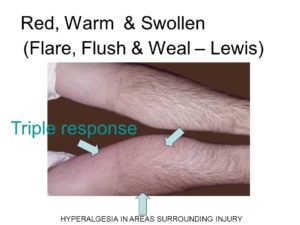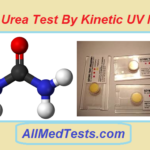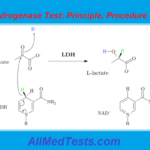A firm strong stroke across the skin using a pencil point or a key produces series of responses classified as:
- Red reaction.
- Flare formation.
- Wheal formation
This is known as triple response.

Red Reaction:
At the site of stroke, a red line appears. It is because of histamine and polypeptide released from the damaged site which cause capillary vasodilation.
Flare Formation:
It is due to dilation of the arterioles and precapillary sphinters which causes irregular erythematous area which surrounds the site of red line. Skin temperature overlying this area is raised. It is mediated by nerves but does not involve central nervous system.
Wheal Formation:
If the stroke stimulus has been strong enough, a swelling of oedema develops spreading from the margins of the red line within the flare area. This is because of increased capillary permeability with rise in capillary pressure because of vasodilation.
Requirement of Test:
A stick or key, spirit and cotton swab and subject.
Procedure:
- Store the skin lightly by smooth end of a stick or a key. A white line appears along the line.
- Stroke the skin firmly. It evokes series of resppnses as follow:
- Red line along the stroke.
- Flare, irregular red area surrounding the red line.
- Wheal, swelling and oedema like appearance spreading from margins of red line within the flare area.
Precautions:
- Clean the area over the skin with spirit swab. To make the skin sterile because there may be scratch during the process of stroke.
- A stick or key should be washed properly in an antiseptic solution.






Leave a Reply